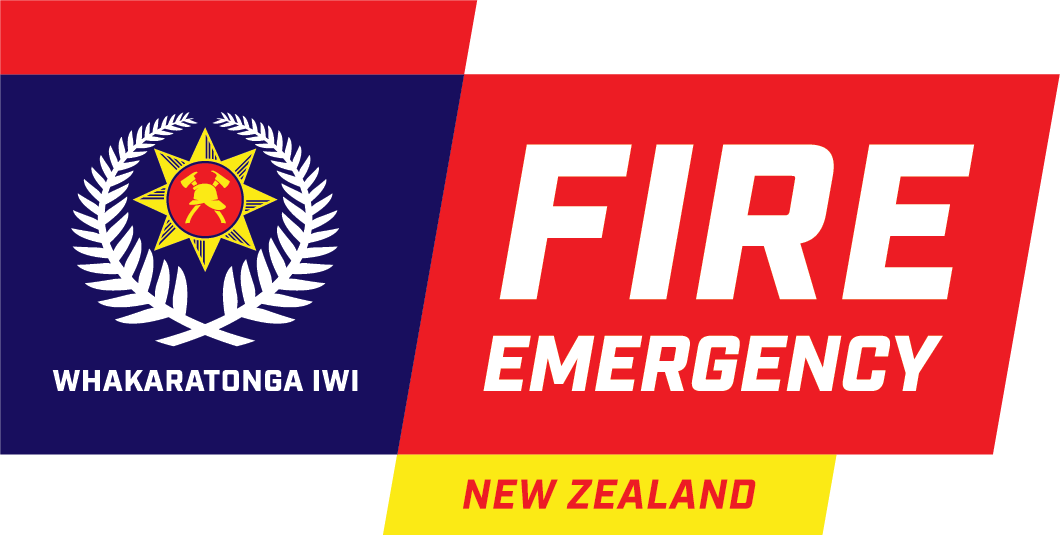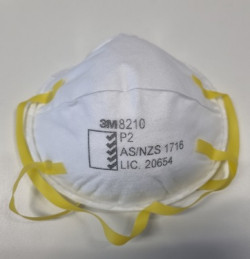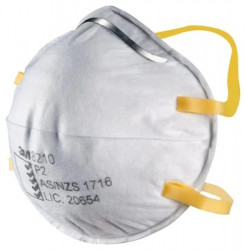Respiratory protection
Types of respiratory protection
Beyond the respiratory protection of BA and APRs, we have a range of other respiratory protection to help keep us safe during COVID-19.
| Type of respiratory protection | Example of mask | Use within Fire and Emergency |
| N95 particulate respirator |  |
During ALL Covid Protection framework settings.
|
| Surgical mask | 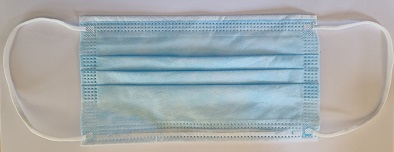 |
|
| Face mask or face covering | 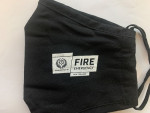 |
These may only be worn under the Green SDCPF setting. You must not wear a Fire and Emergency face covering, or any other face covering, under Orange, Red or Local Lockdown settings. See Surgical mask, above.
|
Disposable N95 particulate respirators
Compliant 3M particulate respirators
From National Notice 052/2021 you will all know that our position on disposable face masks has changed to single product compliant 3M particulate respirators.
All our pandemic PPE supplies are provided by the Ministry of Health (MoH) through the All-of-Government supply process, and it should be noted that we can receive different models of compliant 3M particulate respirators from time to time. For this reason, we will update this page as new models of masks are supplied to us by MoH.
There are various models of 3M particulate respirators for different applications, and so it is important to understand which ones are suitable the pandemic. 3M particulate respirators supplied by the Equipment & Logistics team will be suitable for this purpose.
Note the three versions, and side as well as front views.
| Mask version |
Front |
Side |
|
3M Aura 1870+ |
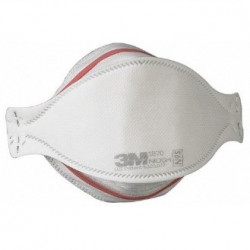 |
|
|
3M 1860S |
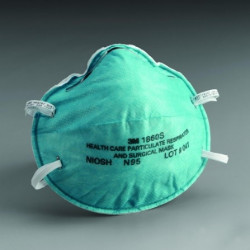 |
 |
|
3M 8210 |
|
|
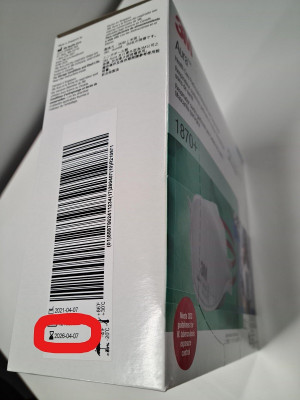
Location of expiry date on box
Other compliant particulate respirators
- 3M Aura series 1870+
- Any respirator with a “P2" rating on the respirator (or packaging) and "AS/NZS 1716:2012" standard
- Any 3M respirator (or with its packaging) marked with “N95” (without exhalation valve)
- Any respirator (or with its packaging) marked with “FFP2”.
Note: Any compliant particulate respirator (as listed above) needs to be within its current expiry date as shown on the box. Any particulate respirators that are past their expiry should not be placed in service, or if already in service they should be removed immediately, and returned to region stores for appropriate disposal to be managed.
Surgical masks
A certified well-fitting medical mask offers a good level of protection. These masks are usually a blue pleated rectangle (or in other colours) with a nose wire and elastic ear loops.
The terms ‘medical’, ‘surgical’, and ‘procedural’ are often used interchangeably to refer to these masks. For use in health care they must comply to specific standards within New Zealand (e.g. AS 4381:2015) or an international equivalent standard to ensure they meet a suitable barrier rating. Some disposable masks may not be certified to medical mask standards.
Non-compliant 3M Aura particulate respirators
3M Aura particulate respirators with a valve on the front are not suitable for pandemic PPE use. This means that these particulate respirators are not to be worn as part of medical emergency response activities. These particulate respirators are typically supplied direct from suppliers (not from the Equipment & Logistics team) as part of business-as-usual purchasing by regions and districts/areas. A typical example of a non-compliant COVID-19 particulate respirators with a valve is shown below.
| Non-Compliant particulate respirators with exhalation valve | |
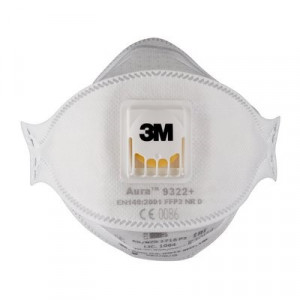 |
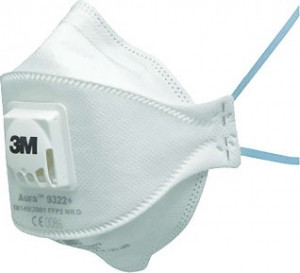 |
Other non-compliant respirators
- Any respirator that has an exhalation valve on the front of it
- QSi ‘Help-It’ respirator masks, regardless of the year of manufacture
- Any “P1” rated respirator cannot be used for operational response
More information
- An instructional video(external link) for fitting particulate respirators has been produced by St John
Low pressure testing for BA
All low pressure tests on BA sets are to be carried out once a week. This means career crews will only do a low-pressure  test once a week, the same as volunteer brigades.
test once a week, the same as volunteer brigades.
Use BA instead of APRs
Operational personnel shall wear Breathing Apparatus (BA) to mitigate the risk of carcinogens for firefighters instead of APRs. This applies to all situations where operational personnel would normally wear a shared APR.
You should continue to minimise exposure to smoke as normal.
APRs are to be removed from appliances temporarily - National Notice 033/2021 refers.
- Senior officers are no longer able to use APRs see National Notice 033/2021 above
Due to the intricate nature of their work, Specialist Fire Investigators are permitted to continue to use APRs, as breathing apparatus is not suitable for this type of work.
Visual inspection of BA mask during routine tests
In CPF settings Green and Orange, the BA mask is to be removed from the mask bag and visually inspected during routine tests (start of shift for career firefighters, weekly for volunteers). This includes checking for debris IN the mask
In CPF setting Red, visual checks should only be carried out in conjunction with the weekly low pressure tests.
Mask communication batteries can be checked at all alert levels. In CPF setting Red this can be done without removing the mask from the bag.
Firefighters should wash or sanitise hands prior to, and after, checking of BA sets at all levels of alert.
It is important that the visual inspection is carried out strictly as described above, to ensure that the mask and BA communications are working.
BA mask washing requirements
Our mask washing products (Asepti and Draeger Safety Wash) are effective for COVID -19 if used in the dilution rates and with the immersion times stated in the BA mask washing procedure.
Washing requirements for operational BA sets are now as follows:
- The mask shall be washed whenever the mask is placed on the wearer’s face.
- During washing, the mask shall be immersed in the wash for 10 minutes, irrespective of which washing solution is being used.
- Firefighters are to ensure that all water is drained from the mask after rinsing and the mask should be properly stowed so that it can dry before being returned to the bag.
- In CPF setting Red, the mask bag must be taped across the dome after the mask is re stowed.
- In other CPF colour settings, there is no need to tape the mask bag.
- The full function test, and, when carried out, the low pressure test, must continue to be done as per the Respiratory Protection Equipment Reference Guide (login required).
The BA mask washing procedure can be found here:
- Draeger Mask Wash Procedure - including APR (login required)
- Asepti Mask wash procedure (login required)
Separate washing requirements for BA masks at NTC and Training Centres are established and managed by Training.
Start up procedure
As a result of the changes made to the washing and testing of BA masks, it is important that firefighters follow the correct start up procedure, as defined in the Respiratory Protection Equipment Reference Guide (login required)
Specialist Fire Investigators only
Background
- A National Notice, (National Notice 20/2020 [PDF, 540 KB]), was issued recommending BA for operational staff.
- The current APR mask used by firefighters are Scott/Draegers, Specialist Fire Investigators use a 3M version, which meets the same requirements.
- To avoid a potential supply issue of the canisters for Scott/Draegers, full BA has been advised for firefighters.
- Firefighters and Investigators have a different risk profile, and Investigators have personal issue canisters.
Update to requirements from the National Notice
When called to an investigation if you have enough canisters to carry out the investigation, you should do so. If you don't then the investigation cannot proceed and alterative arrangements need to be made, such as asking for an investigator from another area that can respond, or contact the national team on 0508 347 3468.
Last modified:
